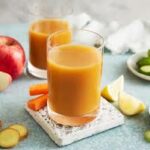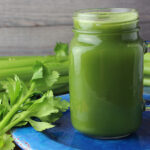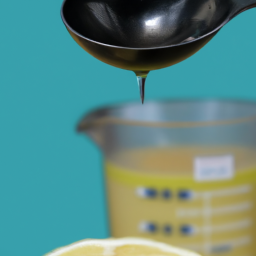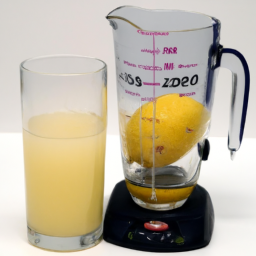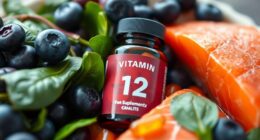Hello! I am excited to share with you my recipe for Bye Bye Belly Juice. Dealing with bloating and digestive issues, I created this drink that has greatly improved my health. Not only is it delicious, but it contains ingredients known for their digestive benefits and anti-inflammatory properties.
Before I dive into the recipe, I want to emphasize the importance of a healthy diet. While drinking a juice alone won’t magically cure all your digestive issues, it can be a helpful addition to a balanced diet. It’s important to prioritize whole foods, plenty of fiber, and hydration to support a healthy gut.
Now, let’s get into the ingredients and equipment needed to make Bye Bye Belly Juice.
Key Takeaways
- Choosing the right ingredients is crucial when making Bye Bye Belly Juice, and it’s important to balance flavors, nutritional value, freshness, and variety.
- Using high-quality produce that has been properly washed and prepared is essential for both taste and nutritional value.
- The recipe for Bye Bye Belly Juice includes cucumber, lemon, apples, ginger root, and spinach, all of which have digestive and anti-inflammatory properties that can improve overall health.
- To reap the benefits of Bye Bye Belly Juice, it’s important to incorporate it into a healthy diet and exercise routine, and to store it properly in the fridge. Consistency is key, and it’s important to avoid common mistakes like skimping on fruits and veggies or using equipment that isn’t suited to the chosen ingredients.
Understanding the Importance of a Healthy Diet
Eating a balanced and nutritious diet is key to saying goodbye to belly fat, so don’t skimp on those fruits and veggies! The importance of hydration can’t be emphasized enough; drinking enough water is crucial for maintaining a healthy weight and promoting overall health.
In addition, incorporating regular exercise into your diet can help boost your metabolism and burn fat more efficiently.
When it comes to choosing the right ingredients for your bye bye belly juice, it’s important to keep in mind the role of a healthy diet. By selecting nutrient-dense fruits and vegetables, you can ensure that your juice is not only tasty but also packed with essential vitamins and minerals.
Choosing the Right Ingredients
Picking out the perfect ingredients can be a fun and exciting part of crafting your own healthy and refreshing beverage. Here are four things to keep in mind when choosing the right ingredients for your Bye Bye Belly juice:
-
Balancing flavors: When selecting ingredients, it’s important to consider their taste and how they will work together in your juice. You want to create a balance of sweet, sour, and bitter flavors to make your juice not only healthy but also delicious.
-
Nutritional value: Your juice should be packed with nutrients that are good for your body. Select fruits and vegetables with high nutritional value, such as kale, spinach, and berries, to make sure you’re getting the most out of your drink.
-
Freshness: Use fresh ingredients whenever possible. This will not only enhance the taste of your juice, but it will also ensure that you’re getting the most nutrients out of your ingredients.
-
Variety: Don’t be afraid to mix and match different ingredients to create a unique flavor profile. Experiment with different fruits, vegetables, and herbs to find the perfect combination for your taste buds.
As you start gathering your ingredients, keep in mind that the quality of your produce will greatly affect the taste and nutritional value of your juice. So, make sure to choose fresh, high-quality ingredients to make the most out of your homemade juice.
Preparing Your Ingredients
Before your ingredients can dance together in harmony, give them a good wash to rid them of any unwanted dirt or grime. This is an important step in ensuring the safety of your drink.
Once your ingredients are washed and dried, it’s time to start preparing them for juicing. Cutting vegetables and fruits effectively will not only make the juicing process easier, but it will also ensure that you extract the maximum amount of juice possible. Make sure to cut your ingredients into small enough pieces to fit into your juice extractor.
There are many juice extractor options available in the market, so it’s important to choose the one that best fits your needs. Some extractors are better for leafy greens, while others may be better for harder fruits and vegetables. To ensure a successful juicing experience, using the right equipment is key.
Having a good quality juice extractor will make all the difference in the quality of your juice. With clean and properly prepared ingredients, and the right equipment, you’re ready to move on to the next step of making your bye bye belly juice.
Using the Right Equipment
To ensure that you have a smooth and efficient juicing experience, you’ll need to use the right equipment for your chosen ingredients. There are a variety of juicers on the market, each with their own strengths and weaknesses. When selecting a juicer, it’s important to consider the type of produce you’ll be juicing and the quantity you plan to juice at one time.
Here are some juicing tips to keep in mind when selecting your equipment and maintaining it for optimal performance:
| Equipment Type | Pros | Cons | Maintenance |
|---|---|---|---|
| Centrifugal Juicer | Fast juicing time, can handle a variety of produce | Less efficient at juicing leafy greens, can be loud | Clean after each use, sharpen blades as needed |
| Masticating Juicer | Can juice leafy greens and hard produce efficiently, less foamy juice | Slower juicing time, can be pricier | Clean after each use, oil moving parts as needed |
| Citrus Juicer | Specifically designed for citrus fruits, easy to use | Limited to only citrus fruits | Clean after each use, store in a dry place |
Now that you have a better understanding of the different types of juicers and their maintenance needs, let’s move on to the recipe for bye bye belly juice.
The Recipe for Bye Bye Belly Juice
Let’s dive into how you can create a delicious and nutritious juice that helps reduce belly fat. I call it the ‘Bye Bye Belly Juice’.
To make this juice, you’ll need a juicer and the following ingredients: 1 cucumber, 1 lemon, 2 apples, 1-inch ginger root, and 2 cups of spinach.
First, wash all the ingredients thoroughly. Then, cut the cucumber, apples, and lemon into small pieces. Peel the ginger root and cut it into small chunks as well. Put all the ingredients into the juicer and blend until you achieve the desired juice consistency.
If the juice is too thick, add a little bit of water to thin it out.
Now that we have the recipe for the Bye Bye Belly Juice, let’s talk about serving suggestions and understanding the health benefits of each ingredient.
Understanding the Health Benefits of Each Ingredient
Get ready to discover the amazing health benefits of the ingredients in this delicious and nutritious juice! The Bye Bye Belly Juice is packed with nutritional benefits that can help improve your overall health and wellness.
Let’s start with the first ingredient, spinach. Spinach is rich in vitamins A, C, and K, as well as iron and fiber. It helps improve digestion, boost immunity, and support healthy bone growth. Adding spinach to your diet can also help regulate blood sugar levels and reduce the risk of chronic diseases.
The second ingredient, cucumber, is also a great addition to this juice. Cucumbers are low in calories and high in water content, making them an excellent choice for hydration and weight loss. They are also rich in antioxidants and anti-inflammatory compounds that help reduce the risk of cancer and other chronic diseases.
To reap the nutritional benefits of these ingredients, it’s recommended to consume at least two servings of fruits and vegetables per day.
Incorporating Bye Bye Belly Juice into your daily routine is a simple and effective way to meet your daily recommended servings of fruits and veggies. But, how can you make sure you don’t forget to drink it? Stay tuned for the next section, where I’ll share some tips on how to make this juice a part of your everyday routine.
Incorporating Bye Bye Belly Juice into Your Daily Routine
Incorporating this nutritious drink into your daily routine is easy and can have a significant impact on your health. Did you know that studies show people who consume at least five servings of fruits and vegetables per day have a lower risk of heart disease and stroke? By consuming Bye Bye Belly Juice, packed with nutrient-dense fruits and vegetables, you can easily reach your daily quota.
Timing and consistency are key when it comes to incorporating Bye Bye Belly Juice into your daily routine. I suggest drinking it in the morning, as it can jumpstart your metabolism and provide you with the energy you need to power through your day.
To ensure consistency, try making enough for a week and storing it in the fridge. Pairing this drink with exercise can enhance its benefits, as exercise has been shown to improve digestion and aid in weight loss.
By incorporating Bye Bye Belly Juice into your daily routine, you can take a proactive step towards improving your overall health and well-being.
As you begin to incorporate this drink into your daily routine, it’s important to avoid common mistakes that can hinder its effectiveness. Let’s take a closer look at some of these mistakes and how to avoid them.
Common Mistakes to Avoid
As I’ve been incorporating Bye Bye Belly Juice into my daily routine, I’ve learned that there are some common mistakes to avoid.
One of the biggest mistakes is overloading on sugars or carbs, which can counteract the positive effects of the juice.
It’s also important to make sure I’m drinking enough water throughout the day, as the juice can be dehydrating.
Finally, I need to be mindful of what I’m eating alongside the juice, as combining it with unhealthy foods can offset any progress I’m making towards a healthier lifestyle.
Overloading on Sugars or Carbs
Indulging in too many sugary treats or carb-heavy meals can leave your belly feeling like a bloated balloon. Not only can it affect your gut health, but it can also lead to weight gain and increase your risk for chronic diseases such as diabetes and heart disease.
Sugary drinks like sodas, energy drinks, and even fruit juices are major offenders when it comes to overloading on sugars. These drinks can contain up to 10 teaspoons of sugar per serving, which is well over the recommended daily intake. However, there are alternatives to sugar that can satisfy your sweet tooth without the negative effects.
Stevia, monk fruit, and honey are natural sweeteners that have a lower glycemic index and won’t cause the same blood sugar spikes as regular sugar. Additionally, incorporating more fiber-rich foods like fruits, vegetables, and whole grains can help slow down the absorption of sugars and carbs in your body.
By being mindful of your sugar and carb intake, you can reduce bloating and improve your overall health. Drinking enough water is also crucial for reducing bloating and maintaining a healthy gut. Without enough water, your body can’t properly digest food and eliminate waste, leading to constipation and bloating.
In the next section, we’ll discuss the importance of staying hydrated and ways to make sure you’re getting enough water throughout the day.
Not Drinking Enough Water
Don’t let dehydration lead to bloating and digestive issues – make sure you’re drinking enough water throughout the day. Staying hydrated is crucial for many bodily functions, including digestion. When you’re dehydrated, your body doesn’t have enough water to break down food properly, leading to constipation and bloating.
In addition to digestion, hydration is important for regulating body temperature, lubricating joints, and carrying nutrients and oxygen to cells. Dehydration symptoms can vary from mild to severe and include thirst, dry mouth, dark urine, fatigue, and dizziness.
To avoid dehydration, aim to drink at least 8 glasses of water a day and more if you’re exercising or in a hot climate.
Ensuring proper hydration is just one step in maintaining a healthy digestive system. It’s also important to combine water with healthy foods and avoid unhealthy ones that can exacerbate digestive issues.
Combining with Unhealthy Foods
You may be tempted to pair your favorite unhealthy foods with your meals, but beware, doing so can wreak havoc on your digestive system and leave you feeling bloated and uncomfortable. Here are some reasons why combining unhealthy foods with your Bye Bye Belly Juice can be a bad idea:
-
High sugar content: Consuming sugary foods can cause a spike in blood sugar levels, which can lead to weight gain and an increased risk of diabetes. Avoid pairing your juice with sugary snacks like candy or soda.
-
High fat content: Fatty foods can slow down digestion and leave you feeling sluggish. Instead of pairing your juice with fried foods or processed snacks, opt for healthier substitutes like nuts or seeds.
-
Large portion sizes: Eating too much of any food can cause discomfort and bloating. Be mindful of portion control when choosing what to pair with your juice.
-
Unhealthy additives: Processed foods often contain unhealthy additives like preservatives and artificial flavors. Stick to whole, unprocessed foods when pairing with your juice for optimal health benefits.
By being mindful of what you’re pairing with your Bye Bye Belly Juice, you can ensure that you’re getting the most out of your healthy drink and avoiding any negative side effects. Remember to choose healthy substitutes, practice portion control, and opt for whole, unprocessed foods to keep your digestive system happy and healthy.
Frequently Asked Questions
Can I substitute any of the ingredients in the Bye Bye Belly Juice recipe?
When experimenting with ingredient substitutes in the Bye Bye Belly Juice recipe, I found that taste variations can be achieved by using different fruits and vegetables. However, be mindful of the nutritional benefits each ingredient provides.
How long does the juice last in the fridge before it goes bad?
The shelf life of homemade juice depends on preservation techniques. Fresh ingredients have a shorter shelf life than frozen ones. Proper refrigeration can extend the life of juice up to 3-4 days.
Can I drink Bye Bye Belly Juice on an empty stomach?
Did you know that drinking juice on an empty stomach can lead to blood sugar spikes? As a nutritionist, I suggest alternating with water or herbal tea. For a healthy alternative to juice, try infusing water with fruit or herbs.
What are some potential side effects of drinking Bye Bye Belly Juice?
I’ve experienced nausea and diarrhea after drinking bye bye belly juice, despite its touted health benefits and weight loss potential. It’s important to be aware of potential side effects and consult with a healthcare provider before starting any new dietary regimen.
Is it necessary to use a specific type of juicer for this recipe?
It’s important to use a juicer that can handle leafy greens and tough veggies when making juice. Centrifugal juicers work well for hard produce, while masticating juicers are better for greens. Experiment with different juicing techniques to find what works best for you.
Conclusion
In conclusion, creating a healthy and delicious drink like Bye Bye Belly Juice is an essential part of maintaining a balanced diet. It’s crucial to understand the importance of using the right ingredients and equipment to achieve the best results possible.
Incorporating this juice into your daily routine can offer a myriad of health benefits, such as reducing inflammation, aiding digestion, and boosting energy levels. One of the most significant benefits of Bye Bye Belly Juice is its ability to reduce bloating and improve gut health.
As someone who’s struggled with digestive issues in the past, I can attest to the positive impact this juice has had on my body. It’s like a gentle hug for my stomach, soothing and nourishing it from the inside out.
So, whether you’re looking to improve your digestive health, reduce inflammation, or simply want to add more fruits and vegetables to your diet, Bye Bye Belly Juice is an excellent choice. Give it a try and see how it can transform not only your body but also your overall well-being. Remember, a healthy diet is key to a happy and fulfilling life.
Ilana has been a vegan for over 10 years. She originally made the switch for health reasons, but soon found herself becoming more and more passionate about the ethical and environmental implications of a vegan lifestyle. Ilana is the author of The Graceful Kitchen, a blog all about veganism. She loves to cook up delicious and nutritious vegan meals, and share her recipes with others who are interested in leading a cruelty-free life. Ilana is also a strong advocate for using whole foods as the foundation of a healthy diet, and believes that going vegan is one of the best ways to achieve this.





